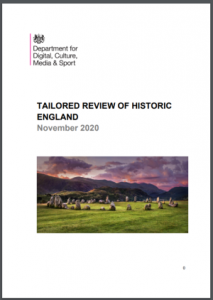 A report from DCMS on Historic England’s capacity to fulfil its mission more effectively and efficiently – including the statutory purpose to ‘secure the preservation of ancient monuments and historic buildings’ – makes 31 recommendations.
A report from DCMS on Historic England’s capacity to fulfil its mission more effectively and efficiently – including the statutory purpose to ‘secure the preservation of ancient monuments and historic buildings’ – makes 31 recommendations.
…review makes 31 recommendations…
…statutory purpose… secure the preservation of ancient monuments and historic buildings in England …
…investment in heritage brings economic benefits…
DCMS writes:
The 2020 Tailored Review of the Historic England involved consultation with a broad range of stakeholders across the UK and beyond, as part of the government’s public bodies reform programme. Tailored reviews require all eligible bodies to undergo a review of their functions, form, performance and governance at least once during each Parliament. This review makes 31 recommendations in these areas.
Founded in 1983 (then as English Heritage) Historic England looks after England’s historic environment by championing historic places, and helping people understand, value and care for them…
HE’s statutory purpose
2.13 HE’s statutory purpose, its duties and functions are defined by the National Heritage Act 1983 as amended by the National Heritage Act 2002.
In summary, they are:
- to secure the preservation of ancient monuments and historic buildings in England (including UK territorial waters adjacent to England);
- to promote the preservation and enhancement of the character and appearance of conservation areas situated in England; and
- to promote the public’s enjoyment, and advance their knowledge of ancient monuments and historic buildings in England (including UK territorial waters adjacent to England).
2.14 HE’s mission is to protect, conserve and promote heritage because of the intrinsic value it holds for people, helping us to understand where we have come from as a nation and guide us on… our way forward.
2.15 In addition to its intangible value, investment in heritage brings economic benefits, for example heritage-based tourism contributed £16.9 billion to the UK’s GDP in…2018 , and social benefits with research… demonstrating the positive effects heritage engagement has on health and wellbeing.
2.16 Historic areas also attract investment as desirable places to live and work, with numerous examples across England of regenerated sites acting as catalysts for social and economic development, particularly involving creative industries….
Download the PDF

